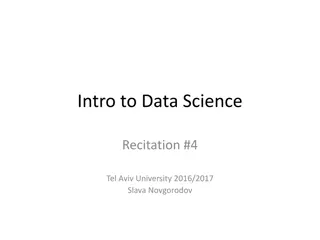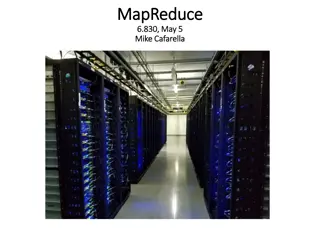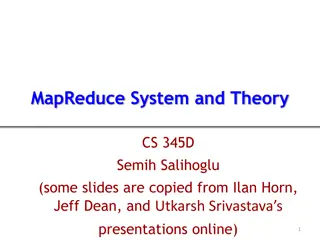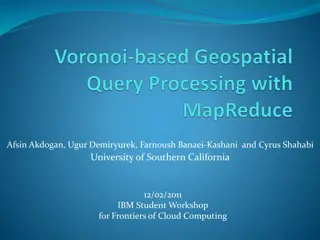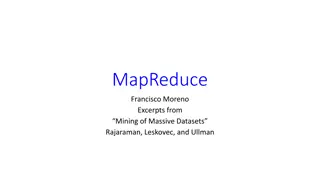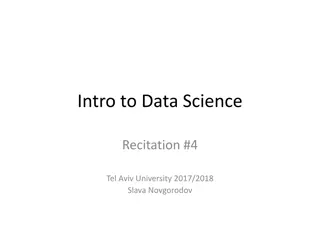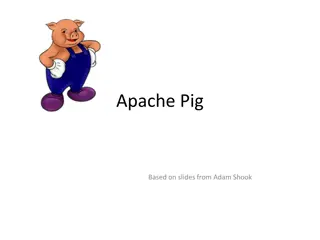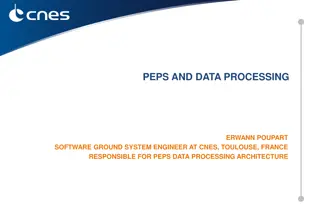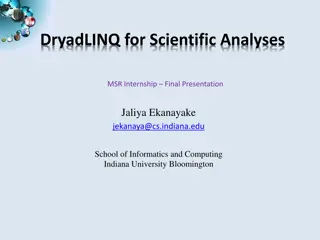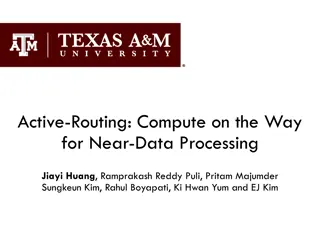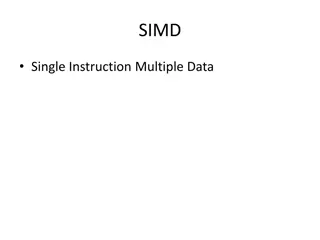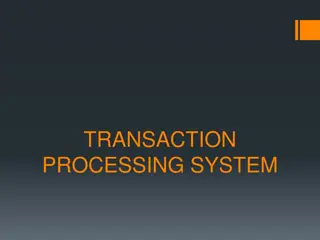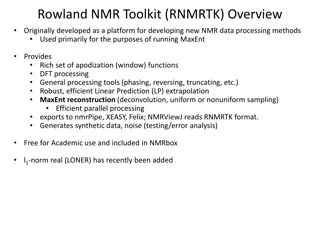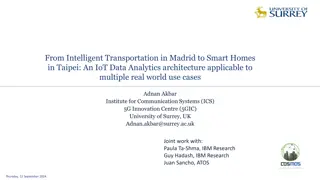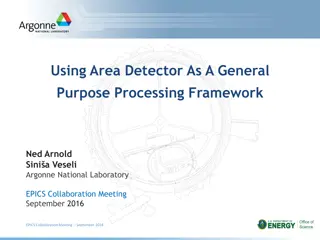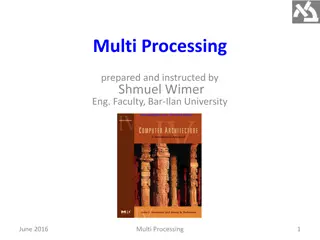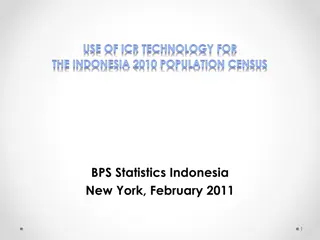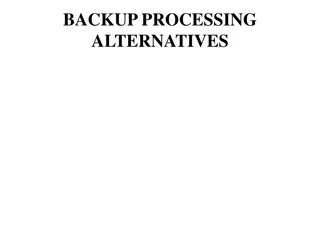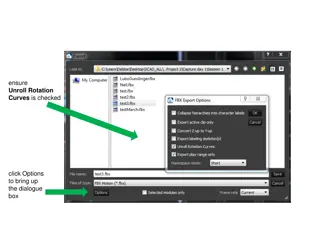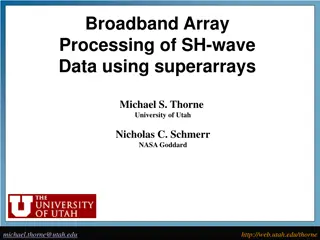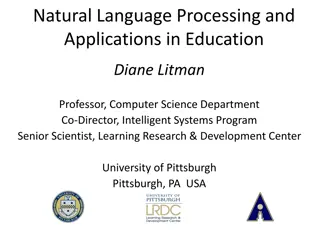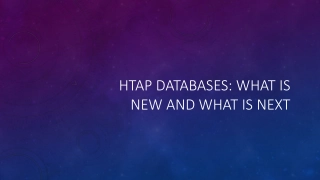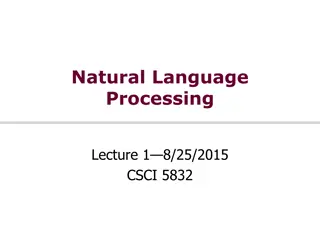Data Processing and MapReduce: Concepts and Applications
Exploring concepts of big data processing, data-parallel computation, fault tolerance in MapReduce, generality vs. specialization in systems, and the efficiency of MapReduce for large computations such as web indexing. Understand the role of synchronization barriers, handling partial aggregation, and the significance of specialized systems in processing data efficiently.
Download Presentation

Please find below an Image/Link to download the presentation.
The content on the website is provided AS IS for your information and personal use only. It may not be sold, licensed, or shared on other websites without obtaining consent from the author. Download presentation by click this link. If you encounter any issues during the download, it is possible that the publisher has removed the file from their server.
E N D
Presentation Transcript
Big Data Processing CS 240: Computing Systems and Concurrency Lecture 23 Marco Canini
Ex: Word count using partial aggregation 1. Compute word counts from individual files 2. Then merge intermediate output 3. Compute word count on merged outputs 3
Putting it together map combine partition ( shuffle ) reduce 4
Synchronization Barrier 5
Fault Tolerance in MapReduce Map worker writes intermediate output to local disk, separated by partitioning. Once completed, tells master node Reduce worker told of location of map task outputs, pulls their partition s data from each mapper, execute function across data Note: All-to-all shuffle b/w mappers and reducers Written to disk ( materialized ) b/w each stage 6
General Systems Can be used for many different applications Jack of all trades, master of none Pay a generality penalty Once a specific application, or class of applications becomes sufficiently important, time to build specialized systems 8
MapReduce is a General System Can express large computations on large data; enables fault tolerant, parallel computation Fault tolerance is an inefficient fit for many applications Parallel programming model (map, reduce) within synchronous rounds is an inefficient fit for many applications 9
MapReduce for Googles Index Flagship application in original MapReduce paper Q: What is inefficient about MapReduce for computing web indexes? MapReduce and other batch-processing systems cannot process small updates individually as they rely on creating large batches for efficiency. Index moved to Percolatorin ~2010 [OSDI 10] Incrementally process updates to index Uses OCC to apply updates 50% reduction in average age of documents 10
MapReduce for Iterative Computations Iterative computations: compute on the same data as we update it e.g., PageRank e.g., Logistic regression Q: What is inefficient about MapReduce for these? Writing data to disk between all iterations is slow Many systems designed for iterative computations, most notable is Apache Spark Key idea 1: Keep data in memory once loaded Key idea 2: Provide fault tolerance via lineage (record ops) 11
MapReduce for Stream Processing Stream processing: Continuously process an infinite stream of incoming events e.g., estimating traffic conditions from GPS data e.g., identify trending hashtags on twitter e.g., detect fraudulent ad-clicks Q: What is inefficient about MapReduce for these? 12
Stream Processing Systems Many stream processing systems as well, typical structure: Definite computation ahead of time Setup machines to run specific parts of computation and pass data around (topology) Stream data into topology Repeat forever Trickiest part: fault tolerance! Notably systems and their fault tolerance Apache/Twitter Storm: Record acknowledgment Spark Streaming: Micro-batches Google Cloud dataflow: transactional updates Apache Flink: Distributed snapshot Specialization is much faster, e.g., click-fraud detection at Microsoft Batch-processing system: 6 hours w/ StreamScope[NSDI 16]: 20 minute average 13
In-Memory Data-Parallel Computation 14
Spark: Resilient Distributed Datasets Let s think of just having a big block of RAM, partitioned across machines And a series of operators that can be executed in parallel across the different partitions That s basically Spark A distributed memory abstraction that is both fault-tolerant and efficient 15
Spark: Resilient Distributed Datasets Restricted form of distributed shared memory Immutable, partitioned collections of records Can only be built through coarse-grained deterministic transformations (map, filter, join, ) They are called Resilient Distributed Datasets (RDDs) Efficient fault recovery using lineage Log one operation to apply to many elements Recompute lost partitions on failure No cost if nothing fails 16
Spark Programming Interface Language-integrated API in Scala (+ Python) Usable interactively via Spark shell Provides: Resilient distributed datasets (RDDs) Operations on RDDs: deterministic transformations (build new RDDs), actions (compute and output results) Control of each RDD s partitioning (layout across nodes) and persistence (storage in RAM, on disk, etc) 17
Example: Log Mining Load error messages from a log into memory, then interactively search for various patterns Msgs. 1 Base RDD Transformed RDD lines = spark.textFile( hdfs://... ) Worker results errors = lines.filter(_.startsWith( ERROR )) tasks Block 1 messages = errors.map(_.split( \t )(2)) Master messages.persist() Action messages.filter(_.contains( foo )).count Msgs. 2 messages.filter(_.contains( bar )).count Worker Msgs. 3 Block 2 Worker Block 3 18
In-Memory Data Sharing . . . iter. 1 iter. 2 Input query 1 one-time processing query 2 query 3 Input . . . 19
Efficient Fault Recovery via Lineage Maintain a reliable log of applied operations . . . iter. 1 iter. 2 Input Recompute lost partitions on failure query 1 one-time processing query 2 query 3 Input . . . 20
Generality of RDDs Despite their restrictions, RDDs can express many parallel algorithms These naturally apply the same operation to many items Unify many programming models Data flow models: MapReduce, Dryad, SQL, Specialized models for iterative apps: BSP (Pregel), iterative MapReduce (Haloop), bulk incremental, Support new apps that these models don t Enables apps to efficiently intermix these models 21
Spark Operations flatMap union join cogroup cross mapValues map filter sample groupByKey reduceByKey sortByKey Transformations (define a new RDD) collect reduce count save lookupKey take Actions (return a result to driver program) 22
Spark Summary Global aggregate computations that produce program state compute the count() of an RDD, compute the max diff, etc. Loops! Spark makes it much easier to do multi-stage MapReduce Built-in abstractions for some other common operations like joins See also Apache Flink for a flexible big data platform 23
Simple stream processing Single node/process Read data from input source (e.g., network socket) Process Write output 25
Examples: Stateless conversion CtoF Convert Celsius temperature to Fahrenheit Stateless operation: emit (input * 9 / 5) + 32 26
Examples: Stateless filtering Filter Function can filter inputs if (input > threshold) { emit input } 27
Examples: Stateful conversion EWMA Compute EWMA of Fahrenheit temperature new_temp = * ( CtoF(input) ) + (1- ) * last_temp last_temp = new_temp emit new_temp 28
Examples: Aggregation (stateful) Avg E.g., Average value per window Window can be # elements (10) or time (1s) Windows can be fixed (every 5s) Windows can be sliding (5s window every 1s) 29
Stream processing as chain CtoF Avg Filter 30
Stream processing as directed graph sensor type 1 alerts CtoF Avg Filter sensor type 2 storage KtoF 31
The challenge of stream processing Large amounts of data to process in real time Examples Social network trends (#trending) Intrusion detection systems (networks, datacenters) Sensors: Detect earthquakes by correlating vibrations of millions of smartphones Fraud detection Visa: 2000 txn / sec on average, peak ~47,000 / sec 32
Scale up: batching Tuple-by-Tuple Micro-batch input read if (input > threshold) { emit input } inputs read out = [] for input in inputs { if (input > threshold) { out.append(input) } } emit out 33
Scale up Tuple-by-Tuple Micro-batch Lower Latency Higher Latency Lower Throughput Higher Throughput Why? Each read/write is an system call into kernel. More cycles performing kernel/application transitions (context switches), less actually spent processing data. 34
Scale out 35
Stateless operations: trivially parallelized C F C F C F 36
State complicates parallelization Aggregations: Need to join results across parallel computations CtoF Avg Filter 37
State complicates parallelization Aggregations: Need to join results across parallel computations Sum Cnt CtoF Filter Sum Cnt Avg CtoF Filter Sum Cnt CtoF Filter 38
Parallelization complicates fault-tolerance Aggregations: Need to join results across parallel computations Sum Cnt CtoF Filter Sum Cnt Avg CtoF Filter - blocks - Sum Cnt CtoF Filter 39
Can parallelize joins Compute trending keywords E.g., portion tweets Sum / key Sum / key portion tweets Sum / key Sort top-k portion tweets - blocks - Sum / key 40
Can parallelize joins Hash 1. merge 2. sort 3. top-k partitioned tweets portion tweets Sum / key Sum / key Sort top-k portion tweets Sum / key Sum / key Sort top-k portion tweets Sum / key Sum / key Sort top-k 41
Parallelization complicates fault-tolerance Hash 1. merge 2. sort 3. top-k partitioned tweets portion tweets Sum / key Sum / key Sort top-k portion tweets Sum / key Sum / key Sort top-k portion tweets Sum / key Sum / key Sort top-k 42
Popular Streaming Frameworks Various fault tolerance mechanisms: 1. Record acknowledgement (Storm) 2. Micro-batches (Spark Streaming, Storm Trident) 3. Transactional updates (Google Cloud dataflow) 4. Distributed snapshots (Flink) 43
Popular Streaming Frameworks 1. Record acknowledgement (Storm) At least once semantics Ensure each input fully processed Track every processed tuple over the DAG, propagate ACKs upwards to the input source of data Cons: Apps need to deal with duplicate or out-of-order tuples 2. Micro-batches (Spark Streaming, Storm Trident) 3. Transactional updates (Google Cloud dataflow) 4. Distributed snapshots (Flink) 44
Popular Streaming Frameworks 1. Record acknowledgement (Storm) 2. Micro-batches (Spark Streaming, Storm Trident) Each micro-batch may succeed or fail On failure, recompute the micro-batch Use lineage to track dependencies Checkpoint state to support failure recovery 3. Transactional updates (Google Cloud dataflow) 4. Distributed snapshots (Flink) 45
Popular Streaming Frameworks 1. Record acknowledgement (Storm) 2. Micro-batches (Spark Streaming, Storm Trident) 3. Transactional updates (Google Cloud dataflow) Treat every processed record as a transaction, committed upon processing On failure, replay the log to restore a consistent state and replay lost records 4. Distributed snapshots (Flink) 46
Popular Streaming Frameworks 1. Record acknowledgement (Storm) 2. Micro-batches (Spark Streaming, Storm Trident) 3. Transactional updates (Google Cloud dataflow) 4. Distributed snapshots (Flink) Take system-wide consistent snapshot (algo is a variation of Chandy-Lamport) Snapshot periodically On failure, recover the latest snapshot and rewind the stream source to snapshot point, then replay inputs 47
Properties of Graph Parallel Algorithms Dependency Graph Factored Computation Iterative Computation What I Like What My Friends Like
ML Tasks Beyond Data-Parallelism Data-Parallel Graph-Parallel Map Reduce ? Feature Extraction Cross Validation Graphical Models Gibbs Sampling Belief Propagation Variational Opt. Semi-Supervised Learning Label Propagation CoEM Computing Sufficient Statistics Collaborative Filtering Tensor Factorization Graph Analysis PageRank Triangle Counting 50


